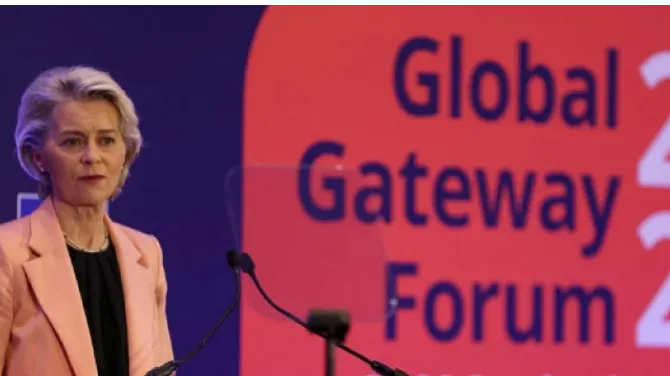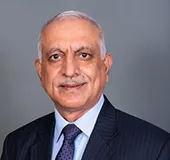-
CENTRES
Progammes & Centres
Location
While the BRI faces resistance from some countries, the GG forum has yet to establish itself. On balance, all these initiatives are bound to coexist in the coming decades.

After a gap of over five years, China hosted the third Belt and Road Forum in Beijing on 17-18 October. A week later, the European Union (EU) hosted the first Global Gateway (GG) Forum in Brussels on 25-26 October. These events were closely watched by analysts and policymakers around the world since they took place at a time when the international security environment is fragile, a fierce and all-domain strategic competition is unfolding, and a sluggish and uncertain global economic recovery is in progress. The BRI Forum this year differed substantially from the first two forums (held in 2017 and 2019) when BRI investments and projects were at their peak, to the current situation where setbacks, criticisms, and challenges to the BRI have been in the headlines. On the other hand, the GG Forum was the first such event from several competing initiatives launched in the last few years, which offer a different value proposition.
A week before the event, China’s State Council Information Office issued a white paper titled ‘The Belt and Road Initiative: A Key Pillar of the Global Community of Shared Future.’ It outlined the progress, achievements, and contributions of BRI in 10 years. It stressed that it belonged to the whole world and was driven by the spirit to “integrate the Chinese dream with the world’s dreams.”
The white paper was intended to showcase the BRI as a highly successful global concept and project, which was essential to replace the undesirable domination of the international system and globalisation by a few countries. It did not mention the United States (US) but underlined that the world does not need outdated approaches of promoting unilateralism, protectionism, and hegemonism. Systematically, it attempted to refute all criticism of the BRI. This included assertions like it’s not a geopolitical tool; it’s not based on any ideology; it has zero tolerance for corruption; it takes care of any potential environmental and ecological impacts, no country has fallen into a debt crisis because of BRI cooperation; it is rules-based; there are no coercive transactions; it supports genuine multilateralism; and it has performed very well in supporting local employment and respecting local laws in partner countries.
The format, style, and terminology used indicated an emphasis to enable easy comparison of the US (in some cases Western) and Chinese visions and approaches, and to covey a collaborative, win-win approach of the Chinese version. Terms like free, open, inclusive, and rules-based were used liberally. Case studies and lists of successful projects in different parts of the world were included, and reports from agencies like the World Bank, McKinsey, and Brugel were used in support of the claims made. The paper admitted that the BRI was facing challenges, but expressed the confidence that these will be overcome, which was along the expected lines.
One hundred and thirty partner countries and 30 international/regional organisations took part in the forum, with some heads of government and leaders of delegations showering lavish praise on the BRI. In his address, President Xi Jinping highlighted the progress and potential of the BRI towards shared peace and prosperity and announced fresh funding support of US$ 100 billion. On completion of the event, the Chinese Ministry of Foreign Affairs released a document, highlighting the list of practical cooperation deliverables. It stressed that the forum had led to 369 concrete outcomes. These included bilateral documents, agreements with international/regional organisations, new schemes and platforms, projects, and people-to-people connectivity programmes. Additional funding schemes by the China Development Bank, the EXIM Bank of China, and the Silk Road Fund were outlined, to indicate that funds for BRI will be made available despite China’s ongoing economic challenges.
The maiden GG Forum in Brussels included representation from 40 governments, the private sector, civil society, financial institutions, and international organisations. It highlighted progress and achievements since its launch two years ago when a plan to invest nearly 300 billion euros by 2027 had been indicated. The first few GG projects had been started in Africa, but subsequently, new projects were launched in Latin America, the Caribbean, the Balkans, Eastern Europe and Caucasus, Asia and the Pacific, and the Mediterranean. The main themes at the forum were: green transitions, critical raw materials, transport corridors, digital infrastructure, health products manufacturing, education, and research. It was brought out that 90 new projects had been launched in 2023 before the forum. Several new projects, with a total value of about 3 billion euros, were signed at the forum. These included projects related to critical raw materials with the Democratic Republic of Congo and Zambia, and clean energy projects with Bangladesh, Cape Verde, Namibia, the Philippines, Tanzania, and Vietnam.
The main themes at the GG Forum were: green transitions, critical raw materials, transport corridors, digital infrastructure, health products manufacturing, education, and research.
The forum was also intended to showcase the progress made under the Partnership for Global Infrastructure and Investment (PGII), launched by G7, which is aligned with the Global Gateway. However, no specific information related to the PGII projects was indicated. The forum was a closed-door meeting, and no statement covering some key details was released soon after the event. Limited high-level representation, including from some leading EU countries, was also noted by many observers.
The GG and the BRI both started primarily as infrastructure connectivity programmes. However, the BRI is no longer limited to such projects, and covers all aspects of bilateral and multilateral transactions including trade, development, social, cultural, art, education, health, science and technology, environment, climate, and media, with appropriate linkages to security. Unlike the GG, the BRI is all-encompassing with the Chinese vision of the world at its core and makes it abundantly clear that it is the primary vehicle for China’s revisionist agenda and ambition for global leadership. On the other hand, the GG is part of the strategic autonomy, sustained key role, and de-risking agenda of the EU.
The BRI is included in the CCP’s Constitution and China’s five-year plans, as the main pillar of China’s foreign policy. All departments and agencies are already aligned and fully committed to the same. It now has many branches covering different sectors, has expanded significantly in its geographical footprint (with about 150 partners compared to about 60 partners of GG), and has already invested around three times the investments planned by GG till 2027. China has also developed a strong organisation for planning and executing the BRI, and similar arrangements are only in their early stages in the EU.
Unlike the GG, the BRI is all-encompassing with the Chinese vision of the world at its core and makes it abundantly clear that it is the primary vehicle for China’s revisionist agenda and ambition for global leadership. On the other hand, the GG is part of the strategic autonomy, sustained key role, and de-risking agenda of the EU.
From the beginning, China has linked the BRI with historical trade routes and connections between civilisations. The EU, on the other hand, seeks to link the GG with European standards in areas such as labour, society, and gender, and its established norms of administration and transparency. The GG also aims to be an alternative that overcomes the shortcomings of BRI.
Both China and the EU are currently facing an economic slowdown and are seeking to balance overseas investments and financing with the imperatives of domestic economic revival. While China has so far progressed the BRI mainly through the government-to-government route, with state-owned enterprises and public banks/financial institutions being the mainstay, the EU aims to have major participation by the private sector. The BRI partners will need to contend with China’s state-level dominance whereas GG partners may need to deal with corporate lobby influence. It is also noteworthy that many EU private sector companies participating in the GG have business interests in China, and 18 EU members are also partners in BRI.
China has adapted to the criticism of inadequate attention to the environmental impact of BRI projects by stressing its alignment with the UN SDG 2030 agenda and the Paris Agreement and has moved to present a clean and green BRI. The EU has also linked the GG with its green transition and climate change agenda. The primary area of competition between the BRI and the GG in the near term is likely to be in renewable and clean energy projects.
The BRI faces resistance and pushback from some countries but is likely to sustain its efforts to expand and develop a positive image. The GG has made a good beginning but is yet to establish itself. As President of the EU Commission, Ursula von der Leyen, mentioned in her remarks at the forum, the GG adopts a new approach that gives choices to other countries. Similar alternatives may be offered by other countries. All these initiatives are likely to co-exist for some time, and choices largely made by partners will shape the global environment in the coming decade.
Vice Admiral Girish Luthra is a Distinguished Fellow at the Observer Research Foundation
The views expressed above belong to the author(s). ORF research and analyses now available on Telegram! Click here to access our curated content — blogs, longforms and interviews.

Vice Admiral Girish Luthra is Distinguished Fellow at Observer Research Foundation, Mumbai. He is Former Commander-in-Chief of Western Naval Command, and Southern Naval Command, Indian ...
Read More +